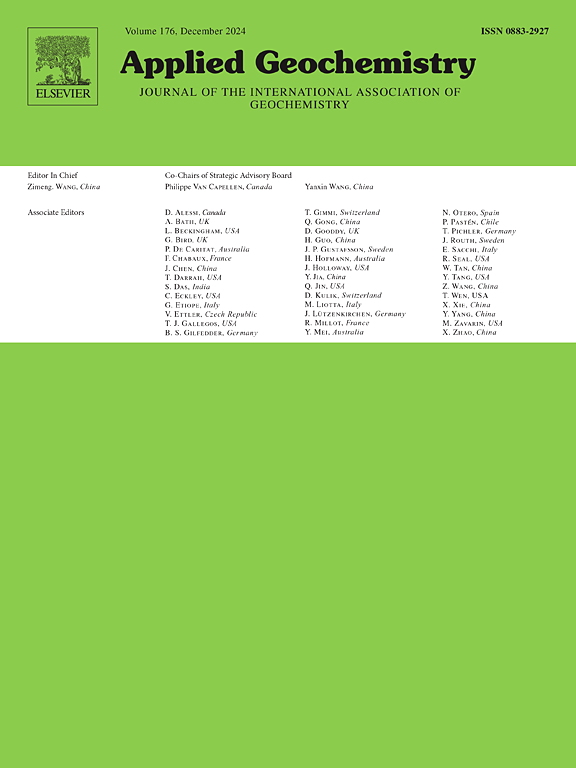Modelling cadmium binding to plant-based biochars using the three-site NICA-Donnan model
IF 3.4
3区 地球科学
Q1 GEOCHEMISTRY & GEOPHYSICS
引用次数: 0
Abstract
In this study, generic three-site NICA model parameters for cadmium (Cd) binding to biochars were derived. For this purpose, five biochars prepared from two mixtures of pure cellulose and lignin and maize straw at different pyrolysis temperatures were selected from our previous work to measure Cd binding in batch experiments. This dataset was complemented with data on Cd binding from five other plant-based biochars taken from literature. The three-site NICA model in combination with an electrostatic Donnan model using a constant Donnan volume of 0.1 L kg−1 successfully described the data, covering a wide range in pH and free Cd2+ concentration in solution. The model provided quantitative insights into the surface speciation of Cd and the electrostatic interactions between Cd and biochar. Carboxylic- and phenolic-type reactive groups exhibited a lower Cd affinity compared to protons, leading to a strong pH dependency of Cd binding. Cadmium ions bind predominantly as a monodentate complex with carboxylic groups and as mono- and bidentate complexes with phenolic groups on biochar. Although phenolic groups have a higher affinity to bind Cd, carboxylic groups dominate Cd binding due to the smaller difference in the affinity of the latter groups to bind Cd and protons. In addition, the small ionic strength effect on Cd adsorption can be ascribed to the low charge density of biochar and the presence of basic groups (i.e., the third type of sites) on biochar. The basic groups generate positive charge, neutralizing to a certain extent the negative charge generated by the acidic groups, thus weakening the ionic strength effect. Due to this electrostatic effect, ignoring the presence of the basic groups will lead to an overestimation of Cd binding by biochar. In addition to these quantitative mechanistic insights, the derived generic model parameters for the three-site NICA-Donnan model can help to predict Cd binding to unknown biochars over a wide range in pH and ionic strength to support the design of in-situ soil remediation operations.
利用三位点NICA-Donnan模型模拟镉与植物基生物炭的结合
本研究导出了镉与生物炭结合的通用三位点NICA模型参数。为此,从我们之前的工作中选择两种纯纤维素和木质素与玉米秸秆在不同热解温度下的混合物制备的五种生物炭,在批量实验中测量Cd的结合。该数据集补充了从文献中获取的其他五种植物基生物炭的Cd结合数据。三位点NICA模型与恒定Donnan体积VD为0.1 L kg−1的静电Donnan模型相结合,成功地描述了数据,涵盖了溶液中pH和游离Cd2+浓度的广泛范围。该模型提供了Cd表面形态和Cd与生物炭之间静电相互作用的定量见解。与质子相比,羧基和酚型反应基团表现出较低的Cd亲和力,导致Cd结合的pH依赖性强。镉离子在生物炭上主要与羧基形成单齿配合物,与酚基形成单齿和双齿配合物。虽然酚基对Cd的亲和力较高,但羧基对Cd的亲和力差异较小,因此在Cd的结合中占主导地位。此外,离子强度对Cd吸附的影响较小可归因于生物炭的低电荷密度和生物炭上存在碱性基团(即第三类位点)。碱性基团产生正电荷,在一定程度上中和了酸性基团产生的负电荷,从而减弱了离子强度效应。由于这种静电效应,忽略基本基团的存在将导致生物炭对Cd结合的高估。除了这些定量机制的见解之外,导出的三位点NICA-Donnan模型的通用模型参数可以帮助预测Cd与未知生物炭在pH和离子强度范围内的结合,以支持原位土壤修复操作的设计。
本文章由计算机程序翻译,如有差异,请以英文原文为准。
求助全文
约1分钟内获得全文
求助全文
来源期刊

Applied Geochemistry
地学-地球化学与地球物理
CiteScore
6.10
自引率
8.80%
发文量
272
审稿时长
65 days
期刊介绍:
Applied Geochemistry is an international journal devoted to publication of original research papers, rapid research communications and selected review papers in geochemistry and urban geochemistry which have some practical application to an aspect of human endeavour, such as the preservation of the environment, health, waste disposal and the search for resources. Papers on applications of inorganic, organic and isotope geochemistry and geochemical processes are therefore welcome provided they meet the main criterion. Spatial and temporal monitoring case studies are only of interest to our international readership if they present new ideas of broad application.
Topics covered include: (1) Environmental geochemistry (including natural and anthropogenic aspects, and protection and remediation strategies); (2) Hydrogeochemistry (surface and groundwater); (3) Medical (urban) geochemistry; (4) The search for energy resources (in particular unconventional oil and gas or emerging metal resources); (5) Energy exploitation (in particular geothermal energy and CCS); (6) Upgrading of energy and mineral resources where there is a direct geochemical application; and (7) Waste disposal, including nuclear waste disposal.
 求助内容:
求助内容: 应助结果提醒方式:
应助结果提醒方式:


